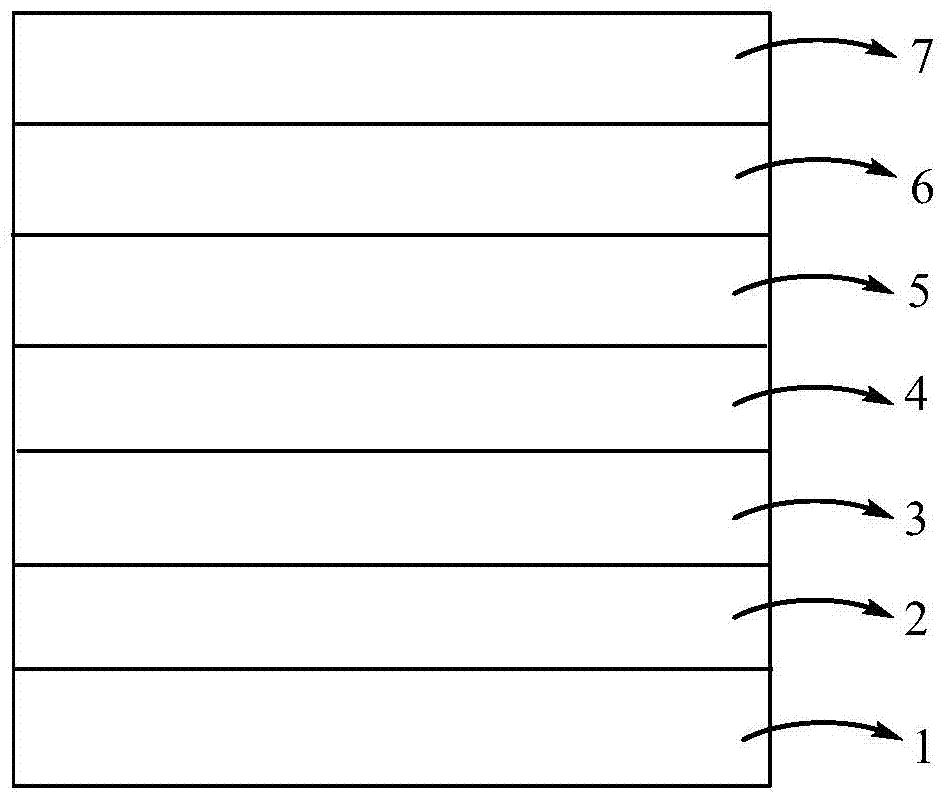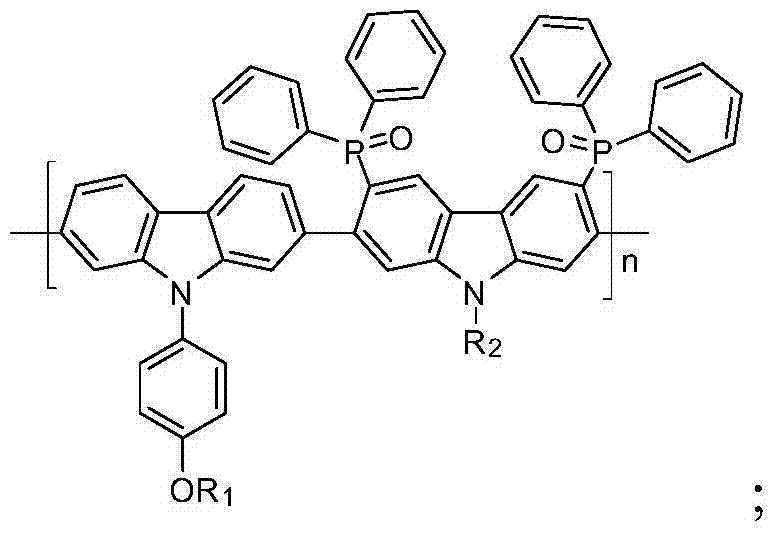Bipolar polymer blue light host material, preparation method and applications thereof
A blue light host material and polymer technology, which can be used in luminescent materials, chemical instruments and methods, semiconductor/solid-state device manufacturing, etc., can solve problems such as low luminous efficiency, and achieve the effects of cheap raw materials, good solubility and novel structure
- Summary
- Abstract
- Description
- Claims
- Application Information
AI Technical Summary
Problems solved by technology
Method used
Image
Examples
Embodiment 1
[0027] Example 1: The bipolar polymer blue light host material of this example, that is, poly{N-(4'-n-hexyloxyphenyl)-2,7-diylcarbazole-co-2,7-diyl -3,6-bis(diphenylphosphineoxy)-9-n-hexyl-9H-carbazole} (P1) (wherein, R 1 , R 2 Both are n-hexyl groups, n=41), and its structural formula is as follows:
[0028]
[0029] The preparation steps of above-mentioned polymer are as follows:
[0030] The reaction formula is as follows:
[0031]
[0032] Under argon protection, N-(4'-n-hexyloxyphenyl)-2,7-dipinacol ester carbazole (119 mg, 0.2 mmol), 2,7-dibromo-3,6-di Add (diphenylphosphineoxy)-9-n-hexyl-9H-carbazole (162mg, 0.2mmol) into a flask containing 10ml of toluene solvent, and after fully dissolving, add potassium carbonate (2mL, 2mol / L) solution into the flask , deoxygenated under vacuum and filled with argon, then added bistriphenylphosphinepalladium dichloride (5.6mg, 0.008mmol); the flask was heated to 100°C for Suzuki coupling reaction for 48h. Subsequently, the...
Embodiment 2
[0035] Example 2: The bipolar polymer blue light host material of this example, that is, poly{N-(4'-methoxyphenyl)-2,7-diylcarbazole-co-2,7-diyl -3,6-bis(diphenylphosphineoxy)-9-n-eicosyl-9H-carbazole} (P2) (wherein, R 1 is methyl, R 2 is n-eicosyl, n=100), its structural formula is as follows:
[0036]
[0037] The preparation steps of above-mentioned polymer are as follows:
[0038] The reaction formula is as follows:
[0039]
[0040] Under the protection of mixed gas of nitrogen and argon, N-(4'-methoxyphenyl)-2,7-dipinacol ester carbazole (158mg, 0.3mmol), 2,7-dibromo-3, Add 6-bis(diphenylphosphineoxy)-9-n-eicosyl-9H-carbazole (302mg, 0.3mmol) and 15mL tetrahydrofuran into a 50mL two-necked bottle, fully dissolve and pass nitrogen and argon After the mixture was exhausted for about 20 minutes, tetrakistriphenylphosphine palladium (4mg, 0.003mmol) was added into it, and after fully dissolved, sodium bicarbonate (3mL, 2mol / L) solution was added. Then, the mixed g...
Embodiment 3
[0042]Example 3: The bipolar polymer blue light host material of this example, that is, poly{N-(4'-n-eicosyloxyphenyl)-2,7-diylcarbazole-co-2,7 -diyl-3,6-bis(diphenylphosphineoxy)-9-methyl-9H-carbazole} (P3) (wherein, R 1 is n-eicosyl, R 2 is methyl, n=75), its structural formula is as follows:
[0043]
[0044] The preparation steps of above-mentioned polymer are as follows:
[0045] The reaction formula is as follows:
[0046]
[0047] Under nitrogen protection, N-(4'-n-eicosyloxyphenyl)-2,7-dipinacol ester carbazole (238mg, 0.3mmol), 2,7-dibromo-3,6- Bis(diphenylphosphineoxy)-9-methyl-9H-carbazole (244mg, 0.33mmol), palladium acetate (3.5mg, 0.015mmol) and tris(o-methylphenyl)phosphine (21mg, 0.06mmol) Add it into a flask containing 12mL of N,N-dimethylformamide, dissolve it fully, add potassium carbonate (3mL, 2mol / L) solution, and then pass nitrogen into the flask and exhaust the air for about 30min; heat the flask to Suzuki coupling reaction was carried out at...
PUM
| Property | Measurement | Unit |
|---|---|---|
| temperature | aaaaa | aaaaa |
| current efficiency | aaaaa | aaaaa |
| luminance | aaaaa | aaaaa |
Abstract
Description
Claims
Application Information
 Login to View More
Login to View More - R&D
- Intellectual Property
- Life Sciences
- Materials
- Tech Scout
- Unparalleled Data Quality
- Higher Quality Content
- 60% Fewer Hallucinations
Browse by: Latest US Patents, China's latest patents, Technical Efficacy Thesaurus, Application Domain, Technology Topic, Popular Technical Reports.
© 2025 PatSnap. All rights reserved.Legal|Privacy policy|Modern Slavery Act Transparency Statement|Sitemap|About US| Contact US: help@patsnap.com



